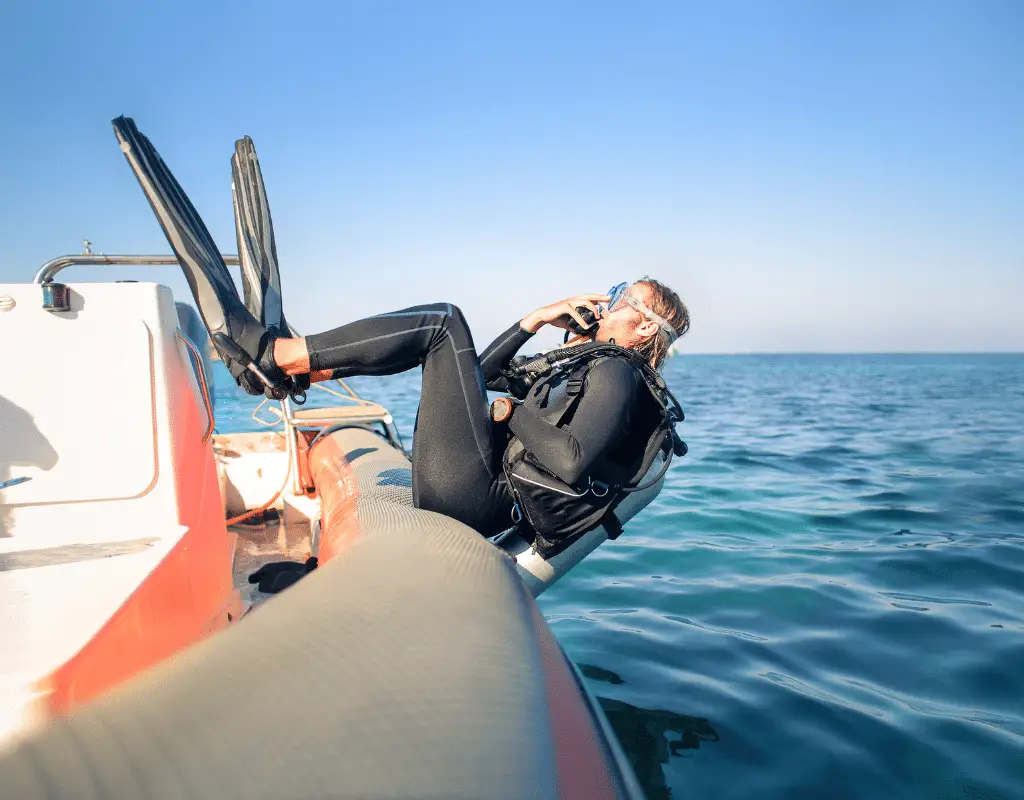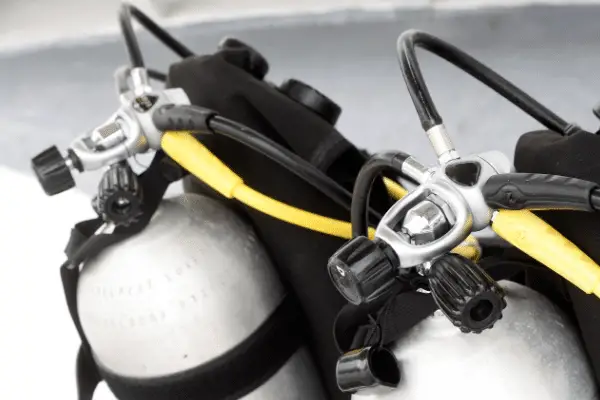Here’s a question often posed as the start of a joke: why do scuba divers dive backward? Scuba divers must think of several contingencies when entering the water to ensure safety. Backward diving is not the only method for entering water amongst scuba divers, yet it remains one of the more popular and widespread ways.

The Main Diving Styles
An important method used for diving into the sea is Giant Stride Entry. This method is the norm when jumping into the water from an elevated position, such as a large boat. A diver would perform the necessary equipment checks, secure the mask and regulator, and walk off the entry platform. The diver remains in an upright position as they enter the water, the feet (wearing fins) entering first. It is a relatively easy technique to master and is often taught in beginner scuba diving classes.
Seated entry is used by divers when entering shallow waters or shark tanks/large aquarium tanks. Divers sit on a ledge or platform facing the water with the lower legs already in the water. By first propping themselves up on upper arms, they are then able to pivot on one arm, turning to fall into the water silently. This method requires some upper body strength and is more challenging to learn.
The last method to be discussed is the backward diving method. It is by far the most commonly used entry method. Preferable when entering from a lower height or an unstable platform such as RIBs (Rigid Inflatable Boats); this method involves the diver being seated on the edge of a boat or deck and falling backward into the water – with the air tank entering the water first. This method is also quickly learned.
But why would divers go in blind, unable to see the water at the moment of diving? Why is the backward diving method preferred over giant stride entry in many situations?
The Physics and Reasons for the backward diving
As indicated, unstable systems benefit from the strategy. Heavy scuba tanks can tumble people off boats. The tank’s gravitational force before or during rearward descent barely affects the boat. Therefore, diving backward won’t disturb the boat (particularly RIBs). On shaky boats, standing up with full scuba gear is challenging. Walking or standing on the boat can cause divers to tumble. As divers’ safety is paramount, sitting on a ledge is the highest stability. Small boats and RIBs have minimal space, so diving from the edge is usually the only choice.
Backward diving is still favoured in boats larger than RIBs since there is little chance of rolling.
Water has high surface tension, which holds molecules together. Water pools into drips and belly flops hurt because of it. To fit the diver, water molecules are displaced. According to physics, your body pushes water molecules away.
The acceleration you fall into the water and the bulk (area) of displaced water determine this force. Depending on how big or small an area must be displaced, entering the water alters the force needed to break surface tension. When reverse diving, the tank relieves surface tension, absorbs shock, and lets you enter the water without the concrete-like force. The weight of the air tank and other equipment makes plunging horizontally into the water painful and disorienting, causing significant injury.Thus, falling backward is best to reduce water surface breakage. Click for “Effects of Scuba Diving on The Body” information.
Backward Diving Effects on Equipment and Safety

Scuba diving equipment is both expensive and necessary. Regular equipment checks are made to ensure there are no surprises underwater. The most common way improper entry affects equipment is to move the mask. This can cause the mask to fill up with water or be taken off entirely, sometimes even shattering. Backward diving tends to have a smaller effect on the scuba mask and regulator. They also avoid the discomfort of the mask smacking into a diver’s face upon collision.
The BCD (Buoyancy Control Device), also known as a stabilizer, is the inflatable equipment scuba divers use to control their buoyancy levels in the water, sinking or floating as needed. Often it is worn on the back, such as a back-pack, and can easily be dislodged or damaged while entering the water. Although the backward diving impacts the air tank and BCD first, the impact of pushing it on the diver instead of taking it off. Often divers will inflate the BCD before diving, further decreasing the chances of moving it too much.
Other equipment such as the pressure regulator (which regulates the pressure of breathing gases) may be damaged in an improper entry. Newcomers to scuba diving are always instructed to enter the water while securing both the regulator and the mask (using the palm of the right hand and fingertips) to avoid displacement or damage upon entry. Diving backward has a smaller impact on the body’s front and hence less risk of equipment loss or damage.
Conclusion
Although there are other techniques that scuba divers occasionally need to use to enter the water, backward diving is by far the safest option in almost all cases. Due to the reduced risk of injury to the diver and relatively low risk of equipment damage – backward diving remains a favored method amongst scuba divers worldwide.
